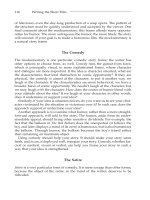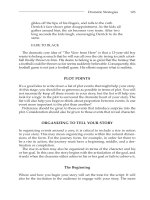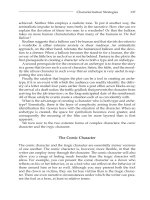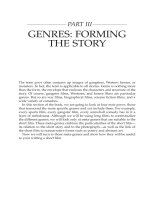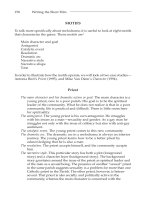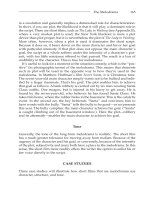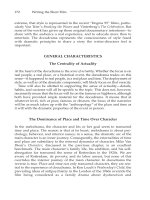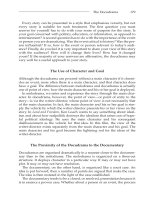Tài liệu Writing the short film 3th - Part 32 pdf
Bạn đang xem bản rút gọn của tài liệu. Xem và tải ngay bản đầy đủ của tài liệu tại đây (153.55 KB, 7 trang )
energy it injects into the story. The consequence of the latter point is that exper-
imental narrative works best for those who are innovative with their stories.
Borrowed styles are obvious, and because the narrative content is often
modest, the borrowed style fails to capture the audience it seeks. The conse-
quence is that the shelf life of an experimental narrative filmmaker tends to
be short. There are exceptions—Buñuel, Tarkovsky—but they are few. When
Richard Lester made A Hard Day’s Night in 1965, he was looking for a style
that would capture the energy and anarchy of the Beatles. He knew their
strength was their music and their individualism, so he sought out a style
that would capture those qualities. In essentially the first MTV-style major
film, Lester created a series of set pieces in A Hard Day’s Night, unified by the
song of the same title. Within that unity he would go anywhere, show any-
thing, shifting tone or point of view. The key was to recreate the energy of
the Beatles. He used multiple cameras, a series of running gags, and an
absurdist attitude—and the rest is history. The MTV style in Oliver Stone’s
Natural Born Killers is a direct descendant of Lester’s film; however, it broad-
ens the stylistic palate to include variances in the style of the set pieces, and
the pace, now 30 years later, has picked up considerably.
The style in Atom Egoyan’s Exotica (1994) is probing. The story, set princi-
pally in a sex bar named Exotica, follows multiple characters. All are
wounded; all are sexually confused. Egoyan uses a restless style, probing for
understanding, finding primarily the characters’ obsessions, delusions, and
smoke screens. It’s as if he is looking for an opening but the characters avoid
it. It is only at the end that he (and we) find that opening; until then it is the
probing, eroticized style that maintains the energy in the story.
The style may focus on stills, as in Chris Marker’s short film La Jetée; it
may focus on long takes, as in Miklos Jansco’s The Round-up; it may focus on
haunting images, as in Michaelangelo Antonioni’s The Passenger; it may be
driven by a fascination with a particular piece of music, such as the use of
the Mamas and the Papas’ “California Dreamin’” in Wong Kar-Wai’s
Chungking Express; or it may contain all of the above characteristics.
Whatever the mix, the distinct style of the experimental narrative infuses a
powerful energy into the experience of the film.
Linkages to the Other Arts
More than any of the other genres in this section, the experimental narrative
takes up the other arts, both for inspiration and for affiliation. All of the arts
struggle with the issues of form and content. But the experimental narra-
tive, unlike melodrama and the docudrama, does not affiliate itself with
realism. Instead, it uses style to probe for psychological meaning, as
opposed to a sociological realism. The work of Buñuel and Dalí, for example,
links directly to Dalí’s paintings, his “dream works.” Chris Marker’s La Jetée
The Experimental Narrative 207
Ch16.qxd 9/27/04 6:11 PM Page 207
links to the tension between photojournalism and fiction. Federico Fellini’s
Satyricon links Dante’s Divine Comedy with the paintings of Heironymous
Bosch. Dovschenko’s Earth and Bertolucci’s The Sheltering Sky link to the epic
poetry of the Far East and the Middle East, respectively. Peter Brook’s
Marat/Sade has everything to do with his own ideas and plays about space as
it is used in the theater.
The key point here is that the experimental narrative links to other arts to
draw inspiration and to use the affiliation to point up the style chosen for the
narrative.
The Intellectual Concept
Not only is experimental narrative tied to the other arts, but it is also linked
directly to intellectual concepts. A few examples will illustrate the point.
Freud’s ideas about sexuality and aggression are influential in the images in
Buñuel/Dalí’s Un Chien d’Andalou. They are even more central in Deren’s
Meshes in the Afternoon. Erik Erikson’s stages of development mix with
Jung’s archetypal ideas in Friedrich’s Sink or Swim (1989). Her self-reflective
autobiography and its structure are also influenced by her father’s anthro-
pological background. The structure of the film, made up of chapters, echoes
an anthropological diary of growing up, from conception to adulthood.
The Abstraction of Character
Character is often less important in experimental narrative than in any other
genre. As in hyperdrama, the character is a vehicle for the ideas of the writer-
director. Whereas in hyperdrama the character has a goal, however, in exper-
imental narrative the character has no apparent goal. Consequently, he or
she is clearly present in the narrative for the purposes of the writer rather
than of the narrative. Identification is not at all likely; we follow characters
in Antonioni’s The Passenger without sympathy or apparent reason, except
that they are in the narrative. In a film like Exotica, there are multiple char-
acters and the absence of an apparent goal precludes identification. We view
them from the outside looking in, rather than from the inside looking out.
Perhaps the most we can say about these characters is to see them as
obsessed, to understand their behavior as habitual (they reject themselves a
good deal of the time), and consequently, to care about their fate, rather than
to see ourselves in them. These observations make us curious as to the rea-
sons for their desire and the consequent self-abnegation. Unlike in hyper-
drama, where the character serves a moral purpose or goal, no such purpose
is obvious for the characters in experimental narrative. They are abstract
208 Writing the Short Film
Ch16.qxd 9/27/04 6:11 PM Page 208
figures—often troubled, always mysterious. Only the style directs us to their
habits and to their obsessions, often commenting on both.
The Reliance on Pattern
What is required when plot and character are downplayed is a style that
invites involvement from the audience, that creates a pattern substituting for
the functions of plot and character. In Exotica, we follow each of the five char-
acters through a gradual revelation of their sexual confusion and the sources
of their despair. In Sink or Swim, the pattern is literary—chapters unfolding
chronologically. In Natural Born Killers, the pattern is the frequent references
to television. Pattern is the grid along which we begin to find structure,
which in turn will lead to meaning, though obvious meaning in the experi-
mental narrative can be elusive. We may be left with no more than a feeling
at the end of the experience of the experimental narrative. Nevertheless, it is
the pattern that gives us pleasure, and the motivation to search for meaning.
Ritualized Tone
Just as hyperdrama uses ritualization of the action to create metaphor, exper-
imental narrative uses the organization of the details, aural and visual, to
develop a tone that creates metaphor. The tone may be poetic, as in Satyricon;
it may be beautifully mysterious and menacing, as in The Passenger; it may
be hallucinatory, as in The Double Life of Veronique; it may be epic and inhu-
mane, as in The Round-up. Whichever tone the filmmaker chooses, that tone
will tend to have a formal quality that ritualizes the behavior of the charac-
ters or creates a metaphor about the sense of place. In Egoyan’s Calendar,
Armenia is every homeland. In Chungking Express, Hong Kong is every ultra-
urban city, throwing people together and yet making each person the loneli-
est in the world. The characters in Exotica are not simply wounded or
confused individuals; they are refugees, running way from 20th-century
alienation.
The Voice of the Author
If most forms of drama (like melodrama, for example) are deliberate, pur-
poseful, focusing on an emotional experience for the audience, no such con-
tained experience is the objective of the writer of experimental narrative. The
feeling sought might be too diffuse or too intense to be dealt with directly. For
this reason, the author seeks out a more indirect or meditative experience for
The Experimental Narrative 209
Ch16.qxd 9/27/04 6:11 PM Page 209
his audience. The writer might feel as much passion as the writer of the
docudrama, but that passion is not as directly accessible to the writer of the
experimental narrative. Whereas the writer of the docudrama uses form to
say, “This is important,” the writer of the experimental narrative uses the
form in a more exploratory way. In a sense, the writer is in the position of the
poet rather than the popular prose writer—it is in the cadences of the words
that a feeling will emerge. Metaphor, image, and feeling substitute for the
dramatic tools the docudrama writer uses—character, plot, and structure.
There is nevertheless a voice—a definite will to convey a feeling, to share an
insight—but what is being shared is not a moral tale, as in hyperdrama, or a
political or social polemic, as in docudrama. It may be very simple or com-
plex, but it is very personal and always surprising.
MOTIFS—CASE STUDIES
In the case of experimental narrative, the presentation of the motifs is con-
siderably different from that of the other genres. The following two case
studies will illustrate those differences. We will look at Atom Egoyan’s
Calendar (1993) and Clara Law’s Autumn Moon (1992).
Calendar
The Main Character and His Goal
The main character in Calendar is a photographer. He goes to Armenia, osten-
sibly to photograph churches for a calendar. He travels with his wife and a
driver. While in Armenia we see only his point of view, never him. He asks
questions, he reacts, but never in a sympathetic manner. His wife acts as the
translator for the driver, explaining the history of the sights. The photogra-
pher seems rigid, defensive, and eventually jealous of the developing rela-
tionship between his wife and the driver. On a deeper level, he seems to be
reacting against her acceptance of being both Armenian and Canadian (she
speaks the language). He, on the other hand, seems a stranger in Armenia,
certainly separated from any sense of identification with the place.
Interspersed with the Armenian sequence is a later sequence, which takes
place in Canada. The photographer has dinners with a number of women,
all from ethnic minorities; each excuses herself when he pours the last glass
of red wine. They ask if they can make a phone call. They each do so. Each
speaks (apparently to lovers) in her mother tongue—French, German, Finnish,
Arabic. As they do, he ruminates on writing to his wife (in Armenia) or to his
foster child (also in Armenia). The scene moves back and forth in time
between Armenia and Canada.
210 Writing the Short Film
Ch16.qxd 9/27/04 6:11 PM Page 210
The Antagonist
There is no overt antagonist in Calendar. However, to the extent that the main
character is torn between his Armenian origins and his Canadian self, he is
his own antagonist. The film seeks no resolution, but the issue of identity—
the struggle between the identity deriving from the mother country and that
deriving from the host country—is the premise in Calendar.
The Catalytic Event
Going to Armenia to photograph churches is the catalytic event.
The Resolution
There is no real resolution in Calendar. Although his wife has stayed in
Armenia and he has returned to Canada, we do not know if the marriage is
ended or simply in trouble. Nor do we know if the wife has remained with
the Armenian driver.
The Dramatic Arc
The story progresses back and forth through time rather than along an arc.
The Armenian sequence has two distinct parts—traveling, and photograph-
ing. Each is presented differently in terms of visual style, but the proximity of
the travel footage contrasts sharply with the more distant images of the pho-
tography footage. The photographer’s point of view unites the two, and the
wife is prominent in both. These Armenian travel sequences contrast with the
stillness and the focus on the photographer in the Canadian sequences.
Repetition of images, points of view, and style mark each sequence.
The Narrative Style
The conventional descriptions of plot-driven or character-driven structures
do not really apply to Calendar. There is a journey to photograph churches
for a calendar, but the character’s struggle is not so much with the pictures
as it is with his resistance to being in Armenia. He is there physically, but
emotionally he is consistently backing away. Back in Canada we see the
actual calendar (the published calendar serves as a transition device
between the visit to take the pictures and the present in Canada). In
Canada, the character tries to relate to women (as his guests), but each
rejects him. The fact that they speak their native language on the phone
implies that his bland Canadian presentation does not engage them.
Consequently, there is no development in the relationship dimension of the
narrative.
The Experimental Narrative 211
Ch16.qxd 9/27/04 6:11 PM Page 211
